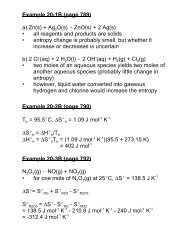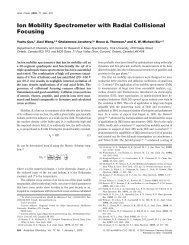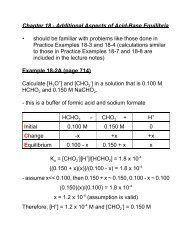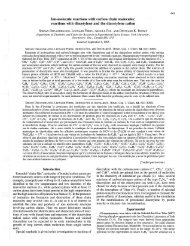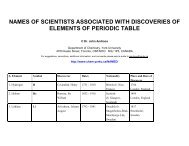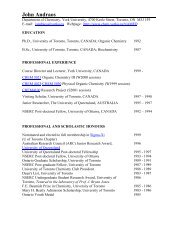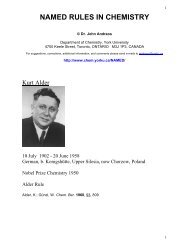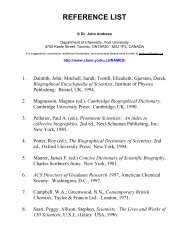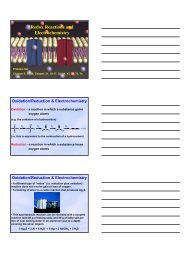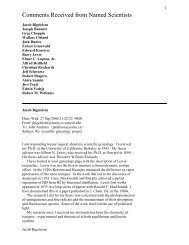Stable Gas-Phase Radical Cations of Dimeric Tryptophan and ...
Stable Gas-Phase Radical Cations of Dimeric Tryptophan and ...
Stable Gas-Phase Radical Cations of Dimeric Tryptophan and ...
You also want an ePaper? Increase the reach of your titles
YUMPU automatically turns print PDFs into web optimized ePapers that Google loves.
J. Phys. Chem. B 2006, 110, 8517-85238517<strong>Stable</strong> <strong>Gas</strong>-<strong>Phase</strong> <strong>Radical</strong> <strong>Cations</strong> <strong>of</strong> <strong>Dimeric</strong> <strong>Tryptophan</strong> <strong>and</strong> Tyrosine DerivativesYuyong Ke, Udo H. Verkerk, P. Y. Iris Shek, Alan C. Hopkinson, <strong>and</strong> K. W. Michael Siu*Department <strong>of</strong> Chemistry <strong>and</strong> Centre for Research in Mass Spectrometry, York UniVersity, 4700 Keele Street,Toronto, Ontario M3J 1P3, CanadaReceiVed: January 2, 2006; In Final Form: March 13, 2006<strong>Stable</strong> radical cations <strong>of</strong> dimeric amino acid derivatives <strong>of</strong> tryptophan <strong>and</strong> tyrosine were generated by collisioninduceddissociation <strong>of</strong> [Cu II (diethylenetriamine)(amino acid derivative) 2 ] •2+ . The yields <strong>of</strong> the dimer radicalcations were dependent on both the auxiliary lig<strong>and</strong> <strong>and</strong> the tryptophan or tyrosine derivatives used. Aminoacid derivatives with an unmodified carboxylic acid group did not generate dimer radical cations. For theamino acid derivatives Ac-Trp-OMe <strong>and</strong> Ac-Trp-NH 2 (Ac is N-acetyl; OMe <strong>and</strong> NH 2 are the methyl ester<strong>and</strong> amide modifications <strong>of</strong> the C-terminal carboxylic group), no auxiliary lig<strong>and</strong> was required for generatingthe dimer radical cations. Collision-induced dissociation <strong>of</strong> the [Cu II (amino acid derivative) 4 ] •2+ precursorgenerated the dimer radical cation [(amino acid derivative) 2 ] •+ . Stabilizing interactions, most likely involvinghydrogen bonding, between the two amino acid derivatives are proposed to account for observation <strong>of</strong> thedimer radical cations. Dissociation <strong>of</strong> these ions yields protonated or radical cationic amino acid derivatives;these observations are consistent with the expectation <strong>of</strong> proton competition between monomeric units, whoseproton affinities were calculated using density functional theory.IntroductionCopper is a c<strong>of</strong>actor in many enzymatic systems. 1-4 Centralto the function <strong>of</strong> copper-based enzymes is the regulatedvariable-coordination environment created by the surroundingpolypeptide matrix. In an attempt to underst<strong>and</strong>, <strong>and</strong> subsequentlyexploit, the potential <strong>of</strong> copper-based catalysts, manycoordination complexes <strong>of</strong> polypeptides <strong>and</strong> copper have beenstudied. The employment <strong>of</strong> electrospray ionization (ESI) 5 hasconsiderably simplified transfer <strong>of</strong> such complexes into the gasphase, allowing analysis by mass spectrometry. The study <strong>of</strong>gas-phase copper complexes, in turn, has grown into an active<strong>and</strong> promising area <strong>of</strong> research. 6-11 <strong>Gas</strong>-phase copper complexes<strong>of</strong> amino acids, for example, were used to distinguish isomeric<strong>and</strong> isobaric amino acids 6,12 <strong>and</strong> to quantify amino acids. 7-9Copper was also shown to direct polypeptide fragmentation toprovide sequence <strong>and</strong> side-chain information. 10Previous work <strong>of</strong> our group 11,13,14 has centered on thefragmentation chemistries <strong>of</strong> [Cu II (L)(M)] •2+ complexes, whereM is an oligopeptide containing the tryptophan (Trp) or tyrosine(Tyr) residue <strong>and</strong> L is an auxiliary tridentate lig<strong>and</strong>, such asdiethylenetriamine (dien). Collision-induced dissociation (CID)<strong>of</strong> these copper complexes results in the formation <strong>of</strong> oligopeptideradical cations. 11,13,14 <strong>Radical</strong> cations <strong>of</strong> small peptides haveconventionally been generated by electron impact 15 <strong>and</strong> UVphotoionization, 16 with limited success. In the past few years,these methods were augmented by charge-stripping, 17 electroncapturedissociation, 18 <strong>and</strong> chemical modification <strong>and</strong> subsequentCID <strong>of</strong> the modified peptides. 19,20 The copper(II)-based methodfor generating radical cations compares favorably with existingmethods <strong>of</strong> peptide radical cation generation, in terms <strong>of</strong>flexibility, scope, <strong>and</strong> ease <strong>of</strong> use, <strong>and</strong> has recently beenextended to nucleobases 21 <strong>and</strong> peptides that do not containresidues <strong>of</strong> low ionization energies. 22* Author to whom correspondence should be addressed. Phone: (416)650-8021. Fax: (416) 736-5936. E-mail: kwmsiu@yorku.ca.In this present work, we explore the formation <strong>and</strong> fragmentationchemistries <strong>of</strong> radical cations <strong>of</strong> dimeric tryptophan <strong>and</strong>tyrosine derivatives. These novel dimeric radical cations, M•+ 2 ,were formed via CID <strong>of</strong> [Cu II (dien)(M) 2 ] •2+ or [Cu II (M) 4 ] •2+ ,where M ) Ac-Trp-OMe, Ac-Trp-NH 2 , Ac-Tyr-OMe, or Ac-Tyr-NH 2 .Experimental SectionExperiments were performed using a commercially availableion-trap mass spectrometer (Finnigan-MAT LCQ) equipped withan ESI source. Typical experimental conditions were: electrosprayvoltage, 4.5 kV; sheath-gas flow, 0.3 L/min <strong>of</strong> nitrogen;capillary temperature, 120 °C; ion-trap temperature, 25 °C.Samples, 100 µM in Cu(ClO 4 ) 2 <strong>and</strong> auxiliary lig<strong>and</strong>, <strong>and</strong> 200µM in amino acid derivatives, were dissolved in 50:50 water/methanol solution <strong>and</strong> infused at a flow rate <strong>of</strong> 3 µL/min.Deionized water <strong>and</strong> methanol were <strong>of</strong> HPLC grade. Forcomparison, acetyl derivatives <strong>of</strong> tryptophan <strong>and</strong> tyrosine werealso examined without the addition <strong>of</strong> the auxiliary lig<strong>and</strong>. Allamino acid derivatives, Ac-Trp-OMe, Ac-Trp-NH 2 , Ac-Trp-OH(C-terminal carboxylic acid), Ac-Tyr-OMe, Ac-Tyr-NH 2 , Ac-Tyr-OH, Trp-OMe, Trp-NH 2 , Trp-OH, Tyr-OMe, Tyr-NH 2 , <strong>and</strong>Tyr-OH were purchased from Bachem BioSciences, Inc. (King<strong>of</strong> Prussia, PA) <strong>and</strong> were used as received. The hexahydratesalt <strong>of</strong> Cu(ClO 4 ) 2 <strong>and</strong> amine lig<strong>and</strong>s diethylenetriamine,2,2′:6′,2′′-terpyridine (tpy), <strong>and</strong> 1,4,7-triazacyclononane (tacn)were available from Sigma-Aldrich (St. Louis, MO).All computations were performed using the Gaussian 98program suite. 23 Density functional theory (DFT) was employedusing the B3LYP correlation functional 24-26 with the 6-31G-(d,p) basis set 27,28 for calculating the proton affinities <strong>of</strong> Ac-Trp-OMe, [Ac-Trp-OMe - H] • , Ac-Tyr-OMe, <strong>and</strong> [Ac-Tyr-OMe - H] • .Results <strong>and</strong> DiscussionComplexes <strong>of</strong> the type [Cu II (L)(M) n ] •2+ (n ) 1-3) werereadily observable under appropriate conditions by means <strong>of</strong>10.1021/jp060029a CCC: $33.50 © 2006 American Chemical SocietyPublished on Web 04/05/2006
8522 J. Phys. Chem. B, Vol. 110, No. 16, 2006 Ke et al.Figure 6. CID mass spectra <strong>of</strong> (a) [Cu II (dien)(Ac-Tyr-OMe) 2] •2+ , (b) [Cu II (dien)(Ac-Tyr(Me)-OMe) 2] •2+ , (c) [(Ac-Trp-OMe)(Ac-Tyr(Me)-OMe)] •+ ,<strong>and</strong> (d) [(Ac-Tyr-OMe)(Ac-Tyr(Me)-OMe)] •+ at relative collision energies <strong>of</strong> 7%, 9%, 9%, <strong>and</strong> 10%, respectively. W ) Trp; Y ) Tyr. The ionsat )192 Th in parts b <strong>and</strong> d are the products <strong>of</strong> [Ac-Tyr(Me)-OMe] •+ after the loss <strong>of</strong> acetamide.similar CID conditions, these mixed species yield a radicalcation <strong>and</strong> a neutral fragment (reactions 10-12).[(Ac-Trp-OMe)(Ac-Tyr(Me)-OMe)] •+f [Ac-Trp-OMe] •+ + Ac-Tyr(Me)-OMe (10)[(Ac-Tyr-OMe)(Ac-Tyr(Me)-OMe)] •+f [Ac-Tyr(Me)-OMe] •+ + Ac-Tyr-OMe (11)f [Ac-Tyr(Me)-OMe + H] + +[Ac-Tyr-OMe - H] • (12)Proposed structures <strong>of</strong> the dimeric radical cations in the form<strong>of</strong> proton-bridged complexes are shown in Scheme 1. The mostacidic hydrogen in the tryptophan derivatives is the indolehydrogen, while in the tyrosine derivatives it is the phenolichydrogen. For the two M 2•+involving identical lig<strong>and</strong>s, (Ac-Trp-OMe) 2 •+ <strong>and</strong> (Ac-Tyr-OMe) 2 •+ , the proposed proton bridgesdepicted in Scheme 1a <strong>and</strong> 1b are exaggerated to showdifferences in proton affinities <strong>of</strong> the components. For the M 2•+involving Ac-Trp-OMe <strong>and</strong> Ac-Tyr-OMe, the structure shownin Scheme 1c is proposed, which reflects differences in PAs.CID <strong>of</strong> these dimeric radical cations results in the radical cation<strong>of</strong> tryptophan-containing derivatives <strong>and</strong> the protonated tyrosinecontainingderivatives.Conclusions<strong>Dimeric</strong> radical cations <strong>of</strong> tryptophan <strong>and</strong> tyrosine derivativescan be generated by collision-induced dissociation <strong>of</strong> copper-(II) complexes formed via electrospray. In specific cases, thepresence <strong>of</strong> an auxiliary lig<strong>and</strong> in such complexes is not aprerequisite for the formation <strong>of</strong> the dimeric radical ions. Results<strong>of</strong> experiments with a derivative <strong>of</strong> the methyl ether <strong>of</strong> tyrosine,a derivative that deters hydrogen bonding, are in accordancewith an interpretation <strong>of</strong> intermolecular hydrogen bonding(between lig<strong>and</strong>s) within the dimeric radical cations. CID <strong>of</strong>the dimeric radical cations yields fragments that are consistentwith results <strong>of</strong> intermolecular proton competition.Acknowledgment. This research is supported by the NaturalSciences <strong>and</strong> Engineering Research Council <strong>of</strong> Canada, MDSSciex, <strong>and</strong> York University. Y.K. acknowledges receipt <strong>of</strong> anOntario Graduate Scholarship.Supporting Information Available: Optimized structures<strong>and</strong> energies <strong>of</strong> the neutral <strong>and</strong> protonated species. This materialis available free <strong>of</strong> charge via the Internet at http://pubs.acs.org.References <strong>and</strong> Notes(1) Copper-Containing Proteins; Valentine, J. S., Gralla, E. B., Eds.;Advances in Protein Chemistry 60; Academic Press: San Diego, CA, 2002.(2) Ferguson-Miller, S.; Babcock, G. T. Heme/Copper TerminalOxidases. Chem. ReV. 1996, 96, 2289-2907.(3) Solomon, E. I.; Chen, P.; Metz, M.; Lee, S.; Palmer, A. E. Angew.Chem., Int. Ed. 2001, 40, 4570-4590.(4) Marko, I. E.; Tsukazaki, M.; Giles, P. R.; Brown, S. M.; Urch, C.J. Angew. Chem., Int. Ed. 1997, 36, 2208-2210.(5) Fenn, J. B. Angew. Chem., Int. Ed. 2003, 42, 3871-3894.(6) Tao, W. A.; Zhang, D.; Nikolaev, E. N.; Cooks, R. G. J. Am. Chem.Soc. 2000, 122, 10598-10609.(7) Seymour, J. L.; Tureček, F. J. Mass Spectrom. 2000, 35, 566-571.(8) Gatlin, C. L.; Tureček, F. J. Mass Spectrom. 2000, 35, 172-177.(9) Lavanant, H.; Hecquet, E.; Hoppilliard, Y. Int. J. Mass Spectrom.1999, 185/186/187, 11-23.(10) Gatlin, C. L.; Rao, R. D.; Tureček, F.; Vaisar, T. Anal. Chem. 1996,68, 263-270.(11) Chu, I. K.; Rodriquez, C. F.; Lau, T.; Hopkinson, A. C.; Siu, K.W. M. J. Phys. Chem. B 2000, 104, 3393-3397.(12) Seymour, J. L.; Tureček, F.; Malkov, A. V.; Kocovsky, P. J. MassSpectrom. 2004, 39, 1044-1052.(13) Chu, I. K.; Rodriquez, C. F.; Hopkinson, A. C.; Siu, K. W. M.;Lau, T. J. Am. Soc. Mass Spectrom. 2001, 12, 1114-1119.(14) Bagheri-Majdi, E.; Ke, Y.; Orlova, G.; Chu, I. K.; Hopkinson, A.C.; Siu, K. W. M. J. Phys. Chem. B 2004, 108, 11170-11181.(15) Biemann, K.; McCloskey, J. A. J. Am. Chem. Soc. 1962, 84, 3192-3193.(16) Weinkauf, R.; Schanen, P.; Metsala, A.; Schlag, E. W.; Burgle,M.; Kessler, H. J. Phys. Chem. 1996, 100, 18567-18585.
<strong>Radical</strong> <strong>Cations</strong> <strong>of</strong> Trp <strong>and</strong> Tyr Derivatives J. Phys. Chem. B, Vol. 110, No. 16, 2006 8523(17) Schröder, D.; Schwarz, H.; Wu, J.; Wesdemiotis, C. Chem. Phys.Lett. 2001, 343, 258-264.(18) Zubarev, R. A.; Kelleher, N. L.; McLafferty, F. W. J. Am. Chem.Soc. 1998, 120, 3265-3266.(19) Masterson, D. S.; Yin, H.; Chacon, A.; Hachey, D. L.; Norris, J.L.; Porter, N. A. J Am. Chem. Soc. 2004, 126, 720-721.(20) Hodyss, R.; Cox, H. A.; Beauchamp, J. L. J. Am. Chem. Soc. 2005,127, 12436-12437.(21) Wee, S.; O’Hair, R. A. J.; McFadyen, W. D. Rapid Commun. MassSpectrom. 2005, 19, 1791-1805.(22) Chu, I. K.; Siu, S. O.; Lam, C. N. W.; Chan, J. C. Y.; Rodriquez,C. F. Rapid Commun. Mass Spectrom. 2004, 18, 1798-1802.(23) Frisch, M. J.; Trucks, G. W.; Schlegel, H. B.; Scuseria, G. E.; Robb,M. A.; Cheeseman, J. R.; Zakrzewski, V. G.; Montgomery, J. A., Jr.;Stratmann, R. E.; Burant, J. C.; Dapprich, S.; Millam, J. M.; Daniels, A.D.; Kudin, K. N.; Strain, M. C.; Farkas, O.; Tomasi, J.; Barone, V.; Cossi,M.; Cammi, R.; Mennucci, B.; Pomelli, C.; Adamo, C.; Clifford, S.;Ochterski, J.; Petersson, G. A.; Ayala, P. Y.; Cui, Q.; Morokuma, K.; Malick,D. K.; Rabuck, A. D.; Raghavachari, K.; Foresman, J. B.; Cioslowski, J.;Ortiz, J. V.; Stefanov, B. B.; Liu, G.; Liashenko, A.; Piskorz, P.; Komaromi,I.; Gomperts, R.; Martin, R. L.; Fox, D. J.; Keith, T.; Al-Laham, M. A.;Peng, C. Y.; Nanayakkara, A.; Gonzalez, C.; Challacombe, M.; Gill, P. M.W.; Johnson, B. G.; Chen, W.; Wong, M. W.; Andres, J. L.; Head-Gordon,M.; Replogle, E. S.; Pople, J. A. Gaussian 98, revision A.11; Gaussian,Inc.: Pittsburgh, PA, 1998.(24) Becke, A. D. Phys. ReV. A1988, 38, 3098-3100.(25) Becke, A. D. J. Chem. Phys. 1993, 98, 5648-5652.(26) Lee, C.; Yang, W.; Parr, R. G. Phys. ReV. B1988, 37, 785-789.(27) Hehre, W. J.; Ditchfield, R.; Pople, J. A. J. Chem. Phys. 1972, 56,2257-2261.(28) Hariharan, P. C.; Pople, J. A. Chem. Phys. Lett. 1972, 16, 217-219.(29) Chu, I. K.; Lau, T.-C.; Siu, K. W. M. J. Mass Spectrom. 1998, 33,811-818.(30) Bertrán, J.; Rodriguez-Santiago, L.; Sodupe, M. J. Phys. Chem. B1999, 103, 2310-2317.(31) Hu, P.; Loo, J. A. J. Am. Chem. Soc. 1995, 117, 11314-11319.(32) Gatlin, C. L.; Tureček, F.; Vaisar, T. J. Am. Chem. Soc. 1995, 117,3637-3638.(33) Barlow, C. K.; Wee, S.; McFadyen, W. D.; O’Hair, R. A. J. J.Chem. Soc., Dalton Trans. 2004, 3199-3204.(34) Wee, S.; O’Hair, R. A. J.; McFadyen, W. D. Rapid Commun. MassSpectrom. 2004, 18, 1221-1226.(35) Berces, A.; Nukada, T.; Margle, O.; Ziegler, T. J. Phys. Chem. A1999, 103, 9693-9701.(36) Wright, R. R.; Walker, N. R.; Firth, S.; Stace, A. J. Phys. Chem.A 2001, 105, 54-64.(37) Walker, N. R.; Wright, R. R.; Barran, P. E.; Murell, J. N.; Stace,A. J. J. Am. Chem. Soc. 2001, 123, 4223-4227.(38) Seymour, J. L.; Tureček, F. J. Mass Spectrom. 2002, 37, 533-540.(39) Combariza, M. Y.; Vachet, R. W. J. Am. Soc. Mass Spectrom. 2002,13, 813-825.(40) Vachet, R. W.; Hartman, J. A. R.; Callahan, J. H. J. Mass Spectrom.1998, 33, 1209-1225.(41) Chaparro, A. L.; Vachet, R. W. J. Mass Spectrom. 2003, 38, 333-342.(42) Henke, W.; Kremer, S.; Reinen, D. Inorg. Chem. 1983, 22, 2858-2863.(43) Sigel, H.; Martin, R. M. Chem. ReV. 1982, 82, 385-426.(44) Shvartsburg, A. A.; Siu, K. W. M. J. Am. Chem. Soc. 2001, 123,10071-10075.(45) Schröder, D.; Schwarz, H. J. Phys. Chem. A 1999, 103, 7385-7394.(46) Jayaweera, P.; Blades, A. T.; Ikonomou, M. G.; Kebarle, P. J. Am.Chem. Soc. 1990, 112, 2452-2454.(47) Blades, A. T.; Jayaweera, P.; Ikonomou, M. G.; Kebarle, P. J. Chem.Phys. 1990, 92, 5900-5906.(48) Stone, J. A.; Vukomanovic, D. Int. J. Mass Spectrom. 1999, 185/186/187, 227-229.(49) Rannulu, N. S.; Rodgers, M. T. Phys. Chem. Chem. Phys. 2005, 7,1014-1025.(50) Gerlach, A.; Unterberg, C.; Fricke, H.; Gerhards, M. Mol. Phys.2005, 103, 1521-1529.(51) Gerhards, M.; Unterberg, C. Phys. Chem. Chem. Phys. 2002, 4,1760-1765.(52) Gerhards, M.; Unterberg, C.; Gerlach, A. Phys. Chem. Chem. Phys.2002, 4, 5563-5565.(53) Chu, I. K.; Lam, C. N. W.; Siu, S. O. J. Am. Soc. Mass Spectrom.2005, 16, 752-762.




